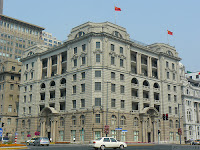Chapter Three
The Bund, one of the most recognizable architectural symbols of Shanghai, extends from Jinling Road in the south to the Waibaidu Bridge over the Suzhou Creek in the north, is on the western bank of the 114 kilometer long Huangpu River, a tributary of the Yangtze River and Shanghai’s most essential waterway.
Of the sights evocative of the splendor and decadence of Old Shanghai, none is singularly more impressive than the Bund. The Bund features a one-mile strip of historic riverfront buildings, one of the most recognizable architectural symbols of Shanghai.
The Bund symbolizes Shanghai's history for hundreds of years and has been given the reputation of "The Oriental Wall Street". Even today, visitors can still feel the prosperity of the old Shanghai, when looking at those old buildings.
For a century, the Bund of Shanghai is always the proud of Shanghai. Every morning people come here to take exercises and every evening people come here to appreciate the excellent view with their lovers. Needless to say, the Bund of Shanghai always shows the cheering changes of Shanghai.
--Here, one can enjoy the beauty of Shanghai mother river - the Huangpu River and the new looks of Lujiazui (one of the most prosper part in Shanghai) in Pudong district on the opposite bank. What’s more, enjoy the Fade Grandeur of Old Shanghai
--Here, one can take a walk amidst luxuriant plants and blooming flowers then appreciate the landscaping of a garden in a bustling metropolis and enjoy the fresh air and bright sunshine rarely found amidst the hustle and bustle of a city.
● The History of the Bund
 |
| The Bund |
The great edifices built here held great symbolic importance. While built of marble and stone, the Bund is emblematic of foreign interest and business anchored in Shanghai’s staying power. They also served to assure Shanghai’s foreign residents and visitors as to who was in control.
When junks and cargo ships reached Shanghai, the promenade along Shanghai’s waterfront was the first sight they would see. These buildings were built with different architectural styles but were well-harmonized which are known as "a Gallery of world architecture".
Although things are different now, the buildings of the Bund retain much of their previous grandeur. Now the buildings are all decorated with floodlights. At night, the Bund is brightly lit, glittering and dazzling to the eye. --Today’s Bund is as evocative of Shanghai’s yesteryears with hints of Shanghai’s tomorrow.
● The surroundings of the Bund
The Bund centers on a stretch of road which named after Sun Yat-sen--the Zhongshan Road. It is a largely circular road which formed the traditional conceptual boundary of Shanghai city "proper".
To the west of the road stand some 52 buildings of various Western classical and modern styles which is the main feature of the Bund. To the east of the road was formerly a stretch of parkland culminating at Huangpu Park. This area is now much reduced due to the expansion of Zhongshan Road. Further east is a tall levee, constructed in the 1990s to ward off flood waters. The construction of this high wall has dramatically changed the appearance of the Bund.
● Sight 1: Bund Sightseeing Tunnel
 |
| Bund Sightseeing Tunne |
● Sight 2: Shanghai Oriental Pearl TV Tower
 |
| Oriental Pearl TV Tower |
Facing the European-style architectures on the Bund, the other side of the Huangpu River, the tower is with multi-functions for sightseeing, catering, shopping and amusement. It is a symbolic building and a tourist attraction in Shanghai. –It is an ideal place to have a bird's eye view of the busy and bustling Huangpu River and the Bund.
● Sight 3: Extensive Architecture Group on the Bund
There are a lot of buildings of different styles on the Bund, such as the Gothic building, the Romanesque building, the Baroque building, etc. It is really an extensive architecture group. The architecture along the Bund is unanimously honored as a “World Architectural Fair.”
 |
| Asia Building |
 |
| Oriental London |
--All in all, the Bund is the epitome of Shanghai’s elegance and it shows the culture of Shanghai and the creation of modern civilization to people.
No comments:
Post a Comment
Thanks for your comment and welcome to China!